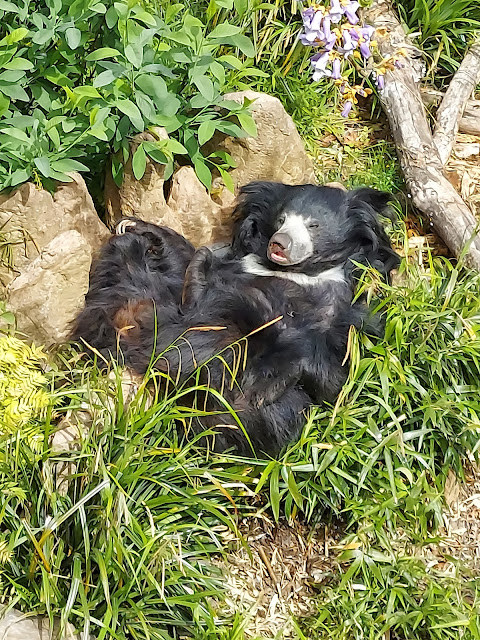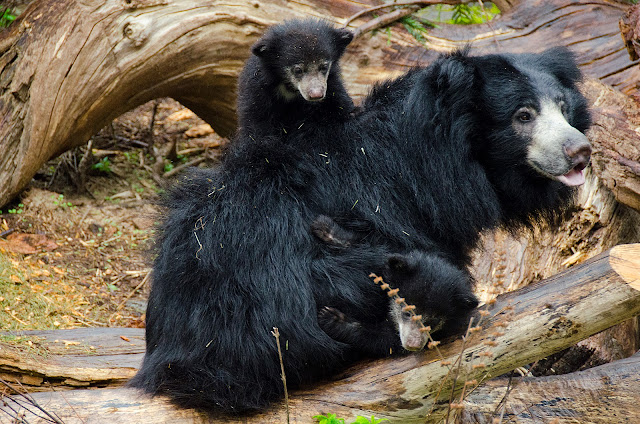Posted by Gigi Allianic, Communications
2022 is off to a wonderful start with the birth of twin sloth bears! The cubs, a boy and a girl, were born on New Year’s Day—the first births of the year at Woodland Park Zoo.
2022 is off to a wonderful start with the birth of twin sloth bears! The cubs, a boy and a girl, were born on New Year’s Day—the first births of the year at Woodland Park Zoo.
 |
| The tiny sloth bear cubs are seen here in the maternity den at 14 days old—eyes still closed. They should be able to open their eyes any day now. Photo: Woodland Park Zoo |
The cubs, who don't have names yet, were born to first-time mom Kushali and dad Bhutan. This is the second litter of cubs for Bhutan and the first successful birth for Kushali, who was born at Woodland Park Zoo in 2012. The last birth of sloth bears at the zoo was in 2017.
Video of the cubs cuddled together in the off-view maternity den. Volume UP!
Sloth bears in zoos are rare, with only 34 currently living in zoos accredited by the Association of Zoos & Aquariums. Every birth of sloth bears is significant for the Sloth Bear Species Survival Plan. Species Survival Plans are cooperative breeding programs across accredited zoos to help ensure healthy, genetically diverse, self-sustaining populations of select species or subspecies.
Mom Kushali and her cubs are currently living in an off-view maternity den where the new family can continue to bond in a quiet, comfortable environment. As part of the zoo’s post-natal care program, the animal keepers have been closely monitoring mom and cubs on a den cam.
Mom Kushali and her cubs are currently living in an off-view maternity den where the new family can continue to bond in a quiet, comfortable environment. As part of the zoo’s post-natal care program, the animal keepers have been closely monitoring mom and cubs on a den cam.
 |
| Sloth bear Kushali is a new mama! Her twin cubs were born on January 1st. Photo: Dennis Dow/Woodland Park Zoo |
“The first couple of weeks were a bit worrisome as we evaluated whether the cubs were getting enough nourishment from nursing,” said Martin Ramirez, mammal curator at Woodland Park Zoo. “However, our round-the-clock monitoring of the cubs confirmed that their needs were being met. As the cubs turn a month old on Feb. 1, we’re very relieved and happy to report that both cubs are nursing regularly, they’re healthy and very vocal, and have full, rounded tummies, all positive signs they’re thriving.
After a gestation period of about six months, sloth bears are born extremely small and blind, and weigh about 1 pound. They open their eyes at about 3 weeks old and can walk at 4 weeks. When the cubs reach about 2 months old, they’ll hitch a ride on mom’s back, a unique behavior that sloth bear mothers do to transport their cubs, and will ride her until they’re 6 to 9 months old.
After a gestation period of about six months, sloth bears are born extremely small and blind, and weigh about 1 pound. They open their eyes at about 3 weeks old and can walk at 4 weeks. When the cubs reach about 2 months old, they’ll hitch a ride on mom’s back, a unique behavior that sloth bear mothers do to transport their cubs, and will ride her until they’re 6 to 9 months old.
 |
| New mom, Kushali is a pretty relaxed bear! Photo: Pam Cox/Woodland Park Zoo |
The cubs will nurse until they’re about a year old. Once they transition to solid foods, their diet will include omnivore chow, honey, browse plants, eggs, a wide variety of fruits and vegetables and, of course, bug treats!
When can you see the new cubs?
“We anticipate introducing the cubs to the public outdoor exhibit in Banyan Wilds sometime in April. We first need to make some upgrades to the exhibit, which will improve the welfare for our bears and enhance the experience for our visitors,” said Ramirez. “Artificial climbing structures will be added for the bears to climb, jump and rest. The elevated structures will also offer guests a better view of the bears, even while the bears are sleeping.”
About Sloth Bears
- Sloth bears live in forests and grasslands in Bangladesh, Bhutan, India, Nepal and Sri Lanka.
- Adult sloth bears are missing their top two front teeth (incisors), which lets them suck ants and termites right out of their underground tunnels, like a vacuum cleaner! Their shaggy, dusty, black coats deflect sunlight, protecting them from the extremes of tropical heat. No wonder they’re fondly described as shaggy slurpers!
- Sloth bears forage for termites, grubs and other insects; they also eat grass, flowers, fruit, and honey plus occasional eggs and cultivated crops. At the zoo, they eat insects, honey, fruits and vegetables, eggs and omnivore chow.
A vulnerable species, sloth bears’ survival is challenged by conflicts with humans and animals for space and food caused by deforestation, the bear parts trade for use in traditional Asian medicines and fragmented populations.
Woodland Park Zoo supports Wildlife SOS, a conservation organization in India that runs wildlife rescue centers and helps communities coexist with sloth bears and other native species. WSOS has permission to collar 10 adult sloth bears with real-time GPS collars. The bears will be tracked for a minimum of two years to observe seasonal patterns of landscape use, with particular attention paid to the overlap of landscape use by sloth bears and humans. The data will identify where bears go and why, helping inform people how to avoid bears and minimize conflict. Visit www.zoo.org/donate to support Wildlife SOS.
What can you do to help sloth bears?
You can "adopt" one of our animals in honor of the new cubs! Woodland Park Zoo's ZooParent program supports our exceptional animal care, education, and wildlife conservation efforts in the Pacific Northwest and around the world. Buy wisely. Choose Forest Stewardship Council (FSC) certified paper and wood products to protect forest habitat and wildlife. By purchasing FSC-certified forest products, consumers help to protect sloth bear habitat by encouraging sustainable forestry and limiting overharvest of forest products (timber, fuelwood, fruits and honey). Without the FSC label, timber may come from illegal logging and forests that are not responsibly managed.


Comments
Post a Comment